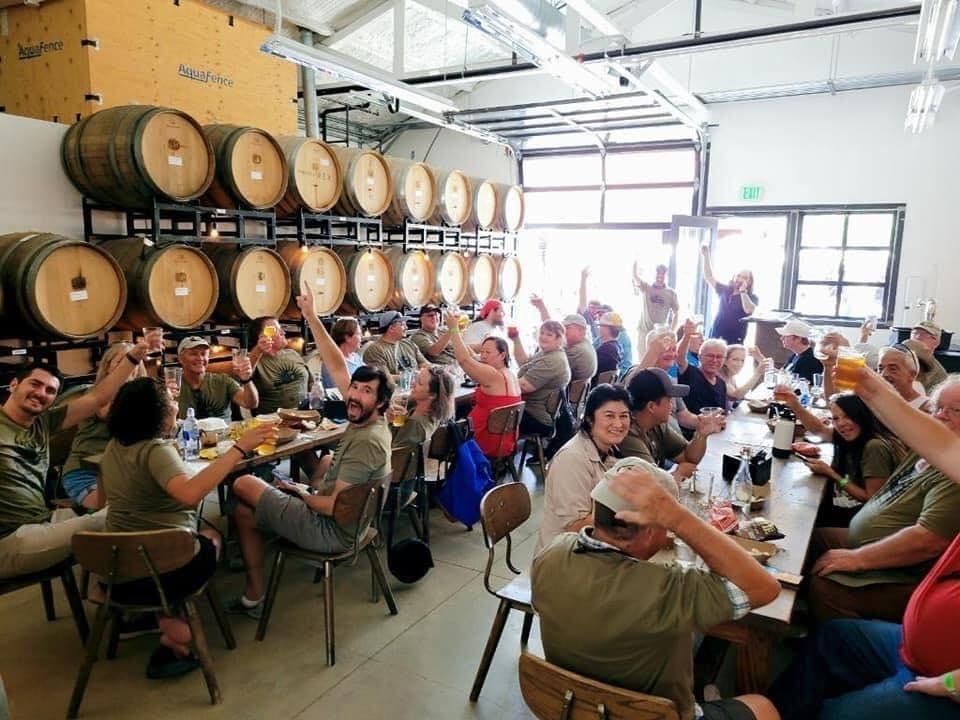
Members of California’s Maltose Falcons, the nation’s oldest homebrewing club, traveled by train to Santa Barbara’s Third Window Brewing.
Tiffany Ashrafi
The craft beer landscape was quite different when the Maltose Falcons formed their homebrewing club in California 51 years ago. Homebrewing was illegal but treated with a wink and a nod, and the country had only one craft brewery of note, San Francisco-based Anchor Brewing. Today, there are thousands of craft breweries, and the 150-member Maltose Falcons are still going strong.
The Maltose Falcons and other homebrewing clubs, such as Connecticut’s Underground Brewers, helped spark the craft beer explosion that has taken the country and the world by storm. The Maltose Falcons are the oldest homebrewing club still operating, and the Underground Brewers say they are the second-oldest after celebrating their 50th anniversary June 20.
“Our club, along with others like the now defunct San Andreas Malts, worked hard to push legalization at the state and federal level in the late ’70s,” says the Maltose Falcons’ Drew Beechum, whose title is the grand hydrometer. “Without that work, I don’t think you see brewing take off in the same way. Every push in craft brewing growth has been fueled by homebrewers saying, ‘I can do this!’”
The Underground Brewers celebrate their 50th anniversary at NewSylum Brewing in Newtown, Connecticut on June 20.
Matt Jordan
The Underground Brewers was also involved in the legalization battle. The club was founded by Pat Baker, who owned a homebrew supply store with Nancy Crosby. The store grew into a wholesaler, Crosby & Baker, which eventually became part of BSG Handcraft, one of the largest suppliers for craft brewers and homebrew stores.
“Homebrewing was not legal at that time, so Crosby & Baker founded the Home Beer and Wine Trade Association which led the legislative fight to change the federal law,” says Paul Hayslett, the Underground Brewers’ current president. “The HBWTA provided the organizational and financial muscle. Legalizing homebrewing vastly increased the number of homebrewers who would eventually become professional brewers.”
Many members of the Maltose Falcons went on to own or brew at craft breweries. Paul Camusi, who co-founded Sierra Nevada Brewing with Ken Grossman, may be the most notable name. Skip Virgilio co-founded San Diego’s AleSmith Brewing, a craft beer giant that three years ago added a new canning line that increased their packaging capacity to 300 cans per minute.
Past and current Underground Brewers members followed similar paths, owning or brewing at Connecticut craft breweries. The breweries include the New England Brewing Company, Two Roads Brewing, City Steam Brewery, Thimble Island Brewing (which recently announced its closure), Stony Creek Brewing, NewSylum Brewing and Watson Farmhouse Brewery.
Baker didn’t become a professional brewer but was the founder of the Beer Judge Certification Program. Today, it’s a wordwide organization with more than 7,500 active beer judges in 60 countries.
The Americn Homebrewers Association says there are more than 1,900 registered homebrew clubs. If you are wondering what happens at a club meeting, let Beechum explain.
“We meet monthly, usually the first Sunday, around noon,” he says. “That makes us a rarity in homebrew circles, because most clubs meet on weekday evenings. Every month, we have an educational topic, such as beer style, theme or technique, presented by the grand hydrometer—me, the chief beer nerd. We conduct club business, mostly about arranging brews, parties and happy hours.”
But that’s only the beginning of the meeting.
“We have lunch, and then we get down to the business of tasting the homebrews brought to the meeting,” Beechum explains. “We put together an ordered list, and each brewer stands up and goes through their recipe and process, while the club tastes the results. Members ask questions and give feedback. Three times a year, we have a festival at a campground with our mobile bar, band and barbecue, because sometimes you just want to have a party!”
Connecticut’s Underground Brewers meet at least once per month and usually have 10 formal judging meetings annually. At the judging meetings, which run two to three hours, each member’s homebrew is blind-tasted.
“We occasionally set aside part of the meeting for education,” Hayslett says. “Recent educational topics have been honey varietals, homemade electronic gadgets used in homebrewing and the control of butyric acid in beer. I will be giving a presentation on Polish meads in the near future.”
The Underground Brewers have a few social gatherings each year, a holiday party in December and a family-friendly picnic in the summer. At a local orchard, the club organizes an annual pressing of heirloom cider apples. Members also get together at their houses for co-brewing sessions or socialize at local breweries.
Tiffanu Ashrafi, the Maltose Falcons’ current president, joined the club in 2012. She says her homebrewing days began at age 10 in upstate New York as the “bottling manager” for her parents, because “I was much lower to the ground than they were, and squatting didn’t ruin my joints.”
Many years later after moving to Los Angeles, she realized why homebrewing meant so much to enthusiasts before the craft beer explosion.
“I didn’t realize what I was getting into at first, but, once I attended my first Maltose Falcons meeting, I was hooked,” Ashrafi recalls. “I learned that there was a reason homebrewing was so important and popular back then. Craft beer on the store shelves and in bars wasn’t nearly as yummy as the brews my new friends made. Craft breweries started popping up everywhere in L.A. and the rest of the nation, with some of our club members becoming brewery owners, head brewers and operations managers. So, in a nutshell, I did not envision the widespread popularity when I first started brewing, but, once I drank the barley Kool-Aid, I knew my new world was about to grow leaps and bounds!”
The craft beer explosion and homebrewers role in it is still perplexing to Beechum.
“It means massive bafflement on the part of everyone wondering: How the heck did that happen?” he says. “Homebrewers are not necessarily the most organized and governance minded, but through luck, pride and stubbornness we’ve kept the ball rolling. It’s also a great excuse for a party and ambitious projects!”











